Stephen L. Herman, Bennie Sparkman. Electricity and Controls for HVAC-R (6th edition)
Подождите немного. Документ загружается.


450 SECTION 7 Ice Maker and Refrigeration Controls
During the harvest cycle, a water solenoid valve opens and permits fresh water to ow into
the sump.
The cube-type ice maker contains two thermostats: the bin thermostat and the cube-size
thermostat.
Flaker-type ice makers produce ice continuously.
In the aker-type ice maker, a oat valve maintains a constant water level in the water
reservoir.
The aker-type ice maker uses a hollow tube as the evaporator.
An auger is used to carry ice up the freezer assembly.
A thermostat located inside the bin of a aker-type ice maker senses when the bin is full.
The auger motor of the aker-type ice maker contains two centrifugal switches.
KEY TERMS
auger aker-type nylobraid tube
bin thermostat freezer assembly psig (pounds per square inch gauge)
cube-size thermostat hot-gas solenoid valve water solenoid valve
REVIEW QUESTIONS
1. Concerning the Scotsman cube-type ice maker, what device is used to cause the water
to ow evenly over the surface of the evaporator plate?
2. Concerning the Scotsman cube-type ice maker, what method is used to thaw the sur-
face of the ice in contact with the evaporator plate during the harvest cycle?
3. Concerning the Scotsman cube-type ice maker, what are the two safety switches used
to disconnect power from the control circuit?
4. What device is used to sense the level of ice cubes in the storage bin of the Scotsman
cube-type ice maker?
5. What electrical component starts the operation of the timer motor in the Scotsman
cube-type ice maker?
6. Concerning the Scotsman aker-type ice maker, what device is used to carry the ice
to the top of the evaporator tube?
7. How is excess water pressed out of the ice before it is ejected into the storage bin of the
aker-type ice maker?
8. Explain the operation of the auger delay switch used in the aker-type ice maker.
9. Concerning the aker-type ice maker, why is it desirable to have the auger drive
motor continue to operate for some period of time after the compressor has stopped
operation?

UNIT 46 Commercial Ice Markers 451
10. What controls the operation of the bottom condenser fan motor in the aker-type ice
maker?
11. What electrical component is used to stop the operation of the compressor if the auger
should become overloaded?
12. Concerning the Scotsman aker-type ice maker, which safety switch must be manu-
ally reset if it trips?

452
Refrigeration and air conditioning systems are
essentially the same in that they both involve
removing heat from the surrounding air. The differ-
ences that occur are in the amount of heat removed
and the operating environment. Air conditioning
systems operate at a higher temperature and are
used for comfort cooling and humidity control.
They generally operate only in the warmer months
and the condenser units are located outside the
structure being cooled.
Refrigeration systems are intended to produce
colder temperatures and generally operate through-
out the year. Some are intended to produce tem-
peratures that range from 35°F to 45°F for food
storage and others produce temperatures of 0°F or
lower for hard freezing. Probably the greatest dif-
ference between air conditioning and refrigeration,
as far as controls are concerned, lies in the fact that
OBJECTIVES
After studying this unit the student should
be able to:
Discuss differences between
refrigeration and air conditioning
control systems
Discuss problems of low head
pressures in a refrigeration system
Discuss ways of improving the
operation of refrigeration systems
Explain condenser fl ooding
Discuss the use of shutters
and dampers
Discuss fan cycling
Refrigeration
Controls
UNIT 47
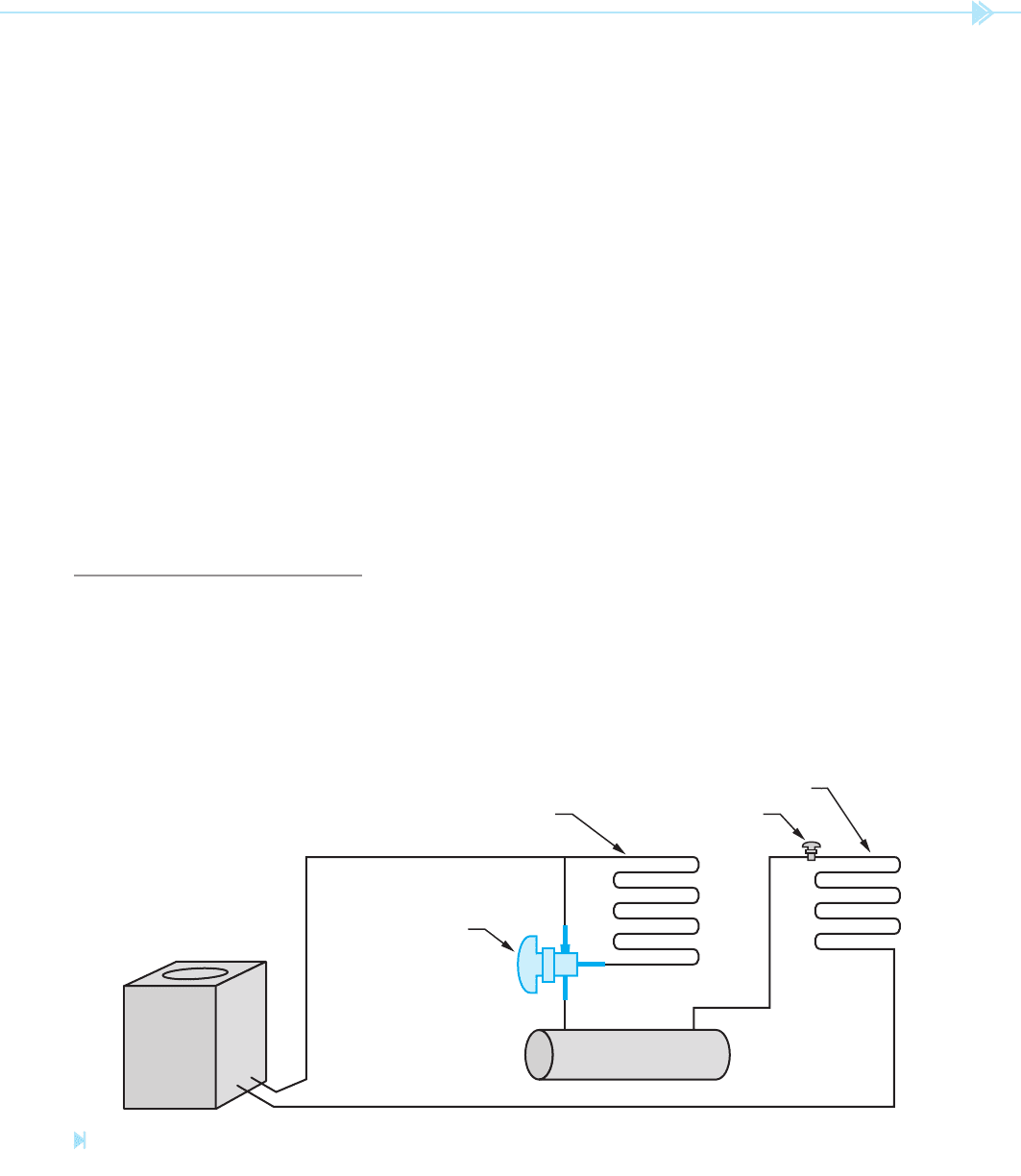
UNIT 47 Refrigeration Controls 453
refrigeration systems operate at lower temperatures
and must employ some method for defrosting the
evaporator.
Many refrigeration systems, such as open freez-
ers in supermarkets, are intended to operate inside
an air conditioned building. It is this operating
environment that can create some special problems.
The cold ambient air temperature in winter or the
cool air inside an air conditioned building can cause
the compressor head pressure to drop below a point
such that the pressure differential between the high
and low side of the system is insuf cient for the unit
to operate ef ciently. When this is the case, some
method must be employed to raise the tempera-
ture of the condenser and permit the compressor
head pressure to increase. Some common ways of
accomplishing this are fan cycle control, shutters,
and condenser ooding. Refrigeration and air condi-
tioning units that employ water-cooled condensers
control the ow of cooling water to maintain head
pressure.
CONDENSER FLOODING
Condenser ooding is accomplished by placing
a pressure operated valve in the refrigerant line
between the condenser and metering valve. More
than one method can be employed to accomplish
this. Flooding the condenser with liquid refrigerant
COMPRESSOR
CONDENSER
HEAD PRESSURE
CONTROL VALVE
EVAPORATOR
METERING VALVE
RECEIVER
has the effect of covering the condenser with a plas-
tic blanket. This causes an increase in condenser
temperature and a corresponding increase in head
pressure. To accomplish condenser ooding, the
unit must contain enough liquid refrigerant to ood
the condenser. This calls for a large charge of refrig-
erant and some means of storing it. Units intended
to use condenser ooding contain a receiver to hold
the excess refrigerant.
Nonadjustable Head
Pressure Valve
Figure 47–1 illustrates the connection of a nonad-
justable head pressure control valve. A line drawing
of the valve is shown in Figure 47–2. The valve’s
main port is between the condenser and receiver.
As long as receiver pressure remains above a certain
level the bypass between discharge and receiver por-
tions of the valve are closed. If the receiver pressure
should drop, such as would be the case with low
ambient temperature, the spring loaded valve over-
comes the receiver pressure and hot gas begins to
ow through the discharge portion of the valve. Low
receiver pressure also causes the valve to decrease
the ow from the condenser, causing refrigerant
to backup in the condenser. This has the effect of
decreasing the surface area of the condenser caus-
ing an increase in temperature and a corresponding
Figure 47–1
The head pressure control valve meters the fl ow of refrigerant through the condenser. (Source: Delmar/Cengage Learning)
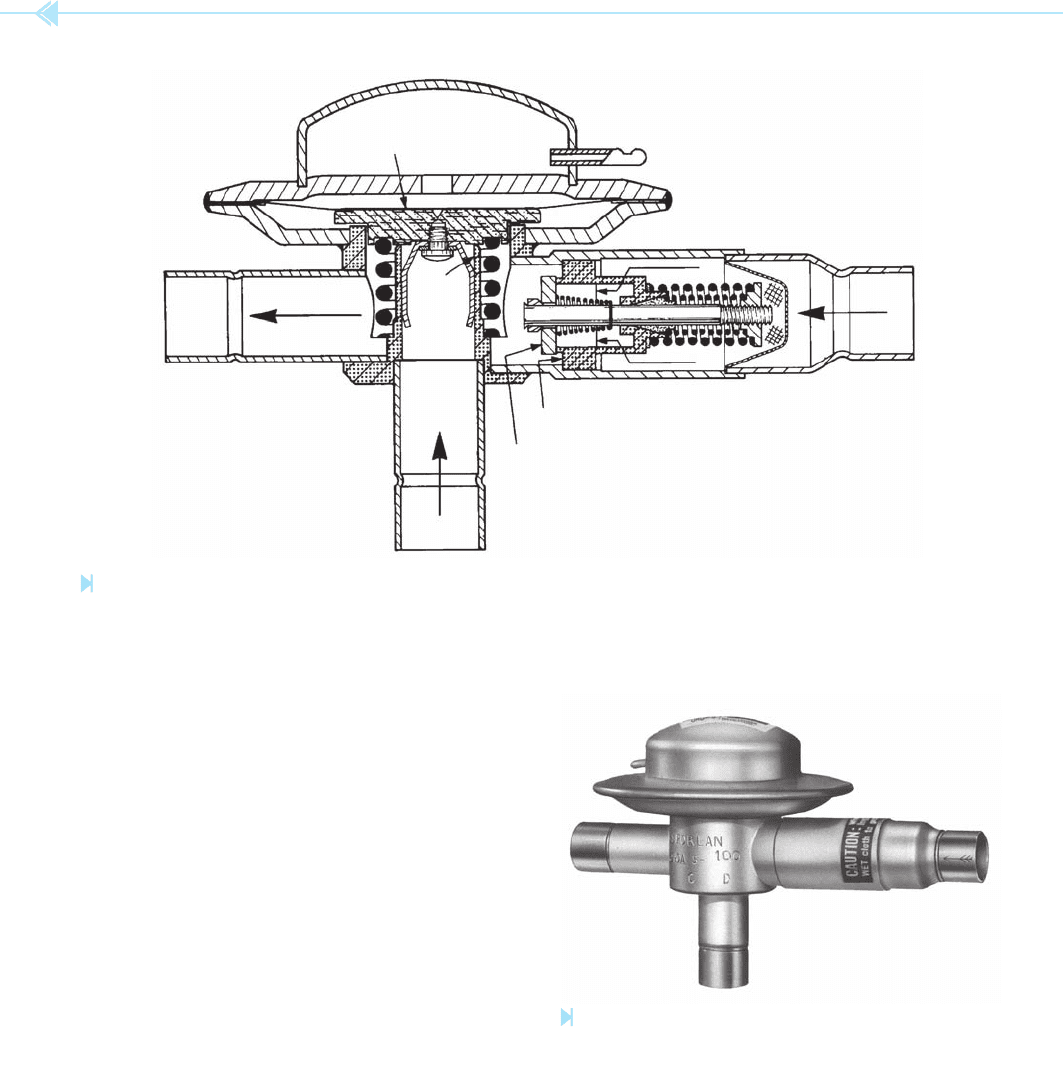
454 SECTION 7 Ice Maker and Refrigeration Controls
Figure 47–2
Operation of a nonadjustable head pressure control valve. (Courtesy of Sporlan Valve Company).
increase in pressure. This valve maintains an almost
constant pressure and function well in temperatures
of up to about –40°F. A nonadjustable head pres-
sure control valve is shown in Figure 47–3.
Adjustable Head Pressure Valve
Adjustable head pressure systems generally require
the use of two valves. One valve opens on rise of
inlet
pressure (ORI) and the other opens on rise
of differential pressure (ORD). A basic piping
connection for the adjustable head pressure system
is shown in Figure 47–4. An illustration of the ORI
valve is shown in Figure 47–5. The ORI valve is
an inlet pressure regulating valve that responds to
changes in the condenser pressure. Note that both
the inlet and outlet pressures are against the seat
disc. One tends to cancel the effects of the other. In
warm weather the condenser pressure is greater
than the receiver pressure, which causes the valve
to open and permit refrigerant to
ow through the
condenser.
Figure 47–3
A nonadjustable head pressure valve. (Courtesy of Sporlan
Valve Company).
The ORD valve provides a bypass around the con-
denser. An illustration of the ORD valve is shown in
Figure 47–6. The compressor head pressure acts to
open the ORD valve and the receiver pressure and
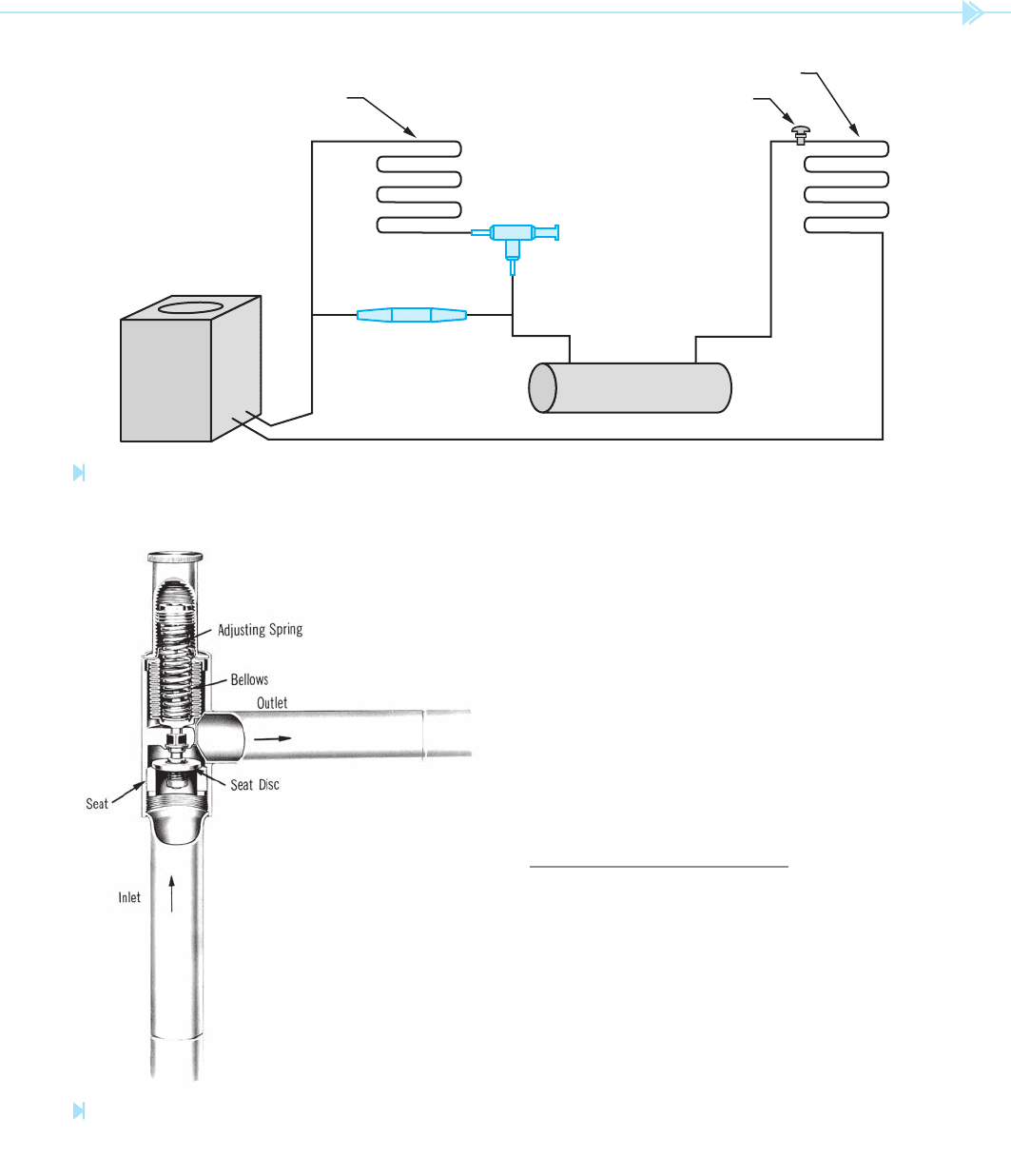
UNIT 47 Refrigeration Controls 455
Figure 47–5
The open on rise of inlet pressure (ORI) valve can be
adjusted. (Courtesy of Sporlan Valve Company).
Figure 47–4
An adjustable head pressure system requires two valves. (Source: Delmar/Cengage Learning)
COMPRESSOR
CONDENSER
ORD VALVE
ORI VALVE
EVAPORATOR
METERING VALVE
RECEIVER
spring tend to keep the valve closed. If the receiver
pressure should drop due to low ambient tempera-
ture, two actions take place.
1. The ORI valve begins to close and reduce the
ow of refrigerant through the condenser.
2. The ORD valve begins to open and permit the
hot gas to bypass the condenser and ow to
the receiver.
The reduced ow of refrigerant through the con-
denser causes an increase in temperature and pres-
sure. An ORI valve is shown in Figure 47–7 and an
ORD valve is shown in Figure 47–8.
FAN CYCLE CONTROL
Another common method of increasing head pres-
sure is by controlling the amount of air across the
condenser. Air-cooled condensers of large refrig-
eration units and air conditioners employ a fan to
increase air ow across them. The increased air ow
permits a greater amount of heat to be removed.
During periods that the ambient temperature is so
low that the head pressure drops below a certain
amount, a fan cycle switch can be used to dis-
connect power to the condenser fan, Figure 47–9.
The switch shown in Figure 47–9 is pressure
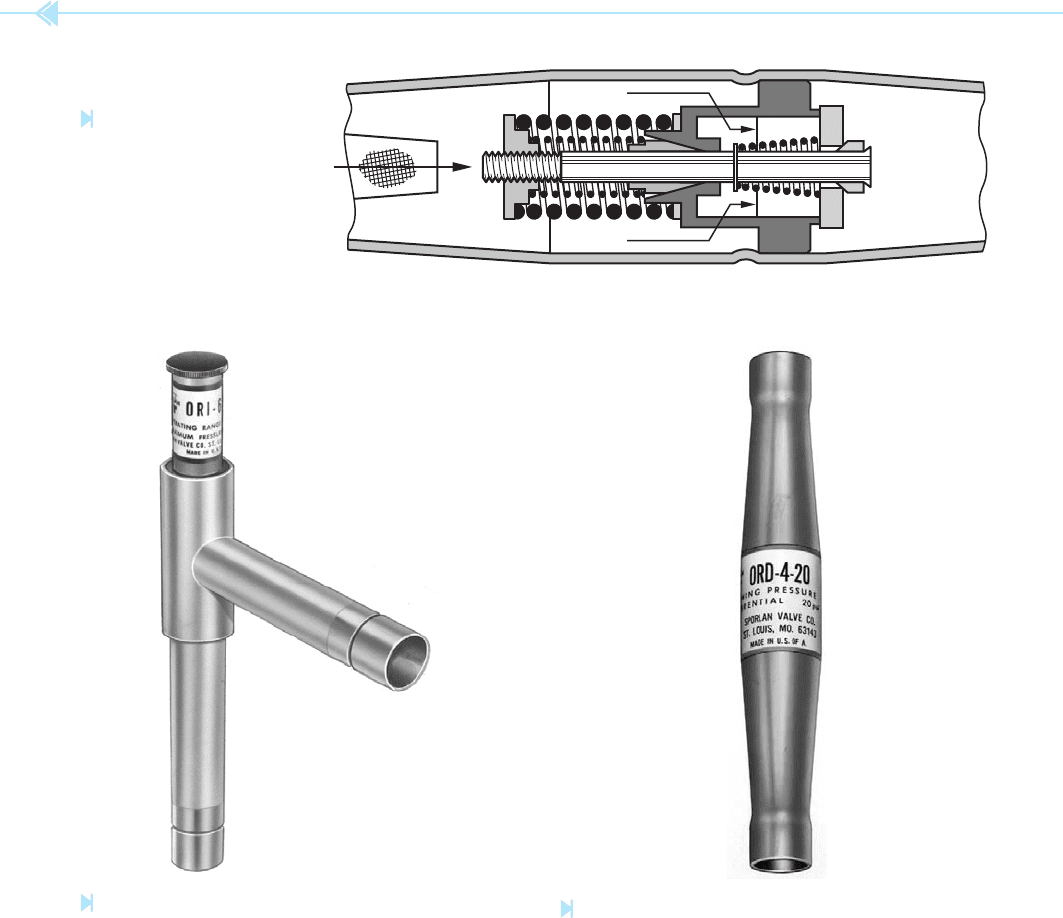
456 SECTION 7 Ice Maker and Refrigeration Controls
Figure 47–6
The open on rise of
differential (ORD) valve
operates on the difference
in pressure between the
compressor head pressure
and receiver pressure.
(Courtesy of Sporlan Valve Company).
Figure 47–7
An open on rise of inlet pressure (ORI) valve. (Courtesy of
Sporlan Valve Company).
Figure 47–8
An open on rise of differential pressure (ORD) valve.
(Courtesy of Sporlan Valve Company).
operated. It is connected in the high side of the unit,
Figure 47–10. The switch can be adjusted for the
amount of pressure required to turn the fan on and
off. A typical setting for refrigerant R12 is 125 psi
turn off and 175 psi turn on. At pressures greater
than 175 psi a set of electrical contacts inside the
switch close and connect the condenser fan to the
power line. If the high side pressure should drop
below 125 psi, the contacts will open and turn off
the condenser fan. The pressure differential prevents
rapid cycling of the condenser fan motor. The fan
cycle switch will not hinder operation during warm
months and will provide good operation during
cold months.
The fan cycle switch is relatively inexpensive
and can be added to an existing system with very
little trouble. Generally no alterations to the piping
system are required. There is one potential problem
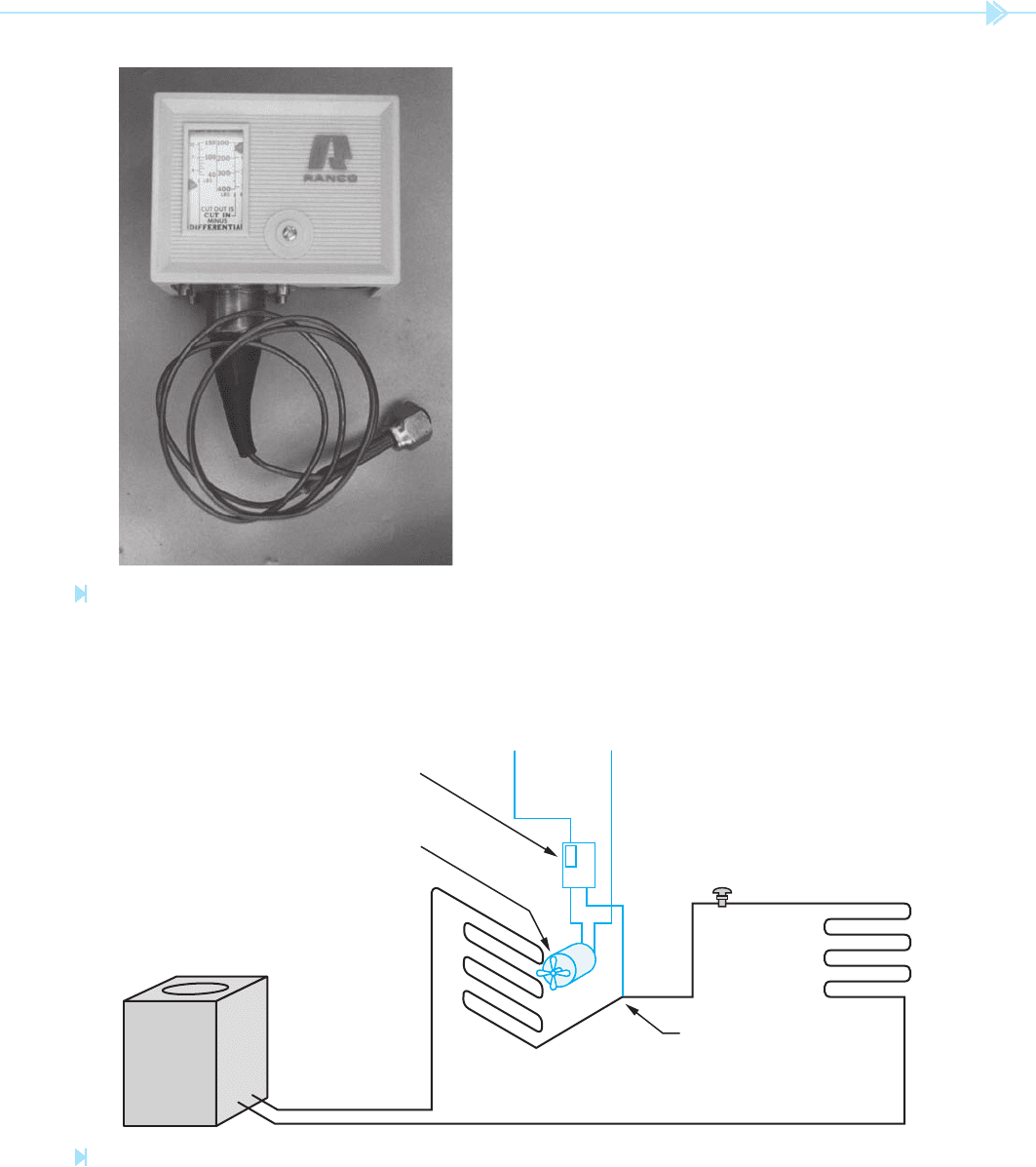
UNIT 47 Refrigeration Controls 457
Figure 47–10
A pressure-operated fan cycle switch controls the condenser fan to control head pressure. (Source: Delmar/Cengage Learning)
Figure 47–9
Pressure operated fan cycle switch. (Source: Delmar/
Cengage Learning)
CONDENSER
FAN
FAN CYCLE
SWITCH
POWER
LINE
L1 L2
FAN SWITCH
CONNECTS TO
THE HIGH SIDE
with this type of head pressure control. The pressure
differential between fan turn on and turn off can
cause erratic operation of the expansion valve.
Units that employ more than one condenser
fan will often have one fan controlled by pressure
and the others controlled by temperature-sensitive
switches. The fans will be set to turn on or off in
stages. One temperature switch, for example, may
turn a fan off at 75°F and another switch may turn a
fan off at 65°F. This helps maintain a more constant
head pressure. When temperature switches are
used, the temperature sensing element is generally
connected to the liquid line.
Variable Speed Control
Another type of fan cycle control employs a solid
state device called a triac to control motor speed,
Figure 47–11. The triac has the ability to control the
output voltage applied to the motor. Refer to Unit 56
for more information concerning the operation of a
triac. Some controls vary the output voltage applied
to the condenser fan in accord with the temperature
of the liquid refrigerant line, and others sense ambient
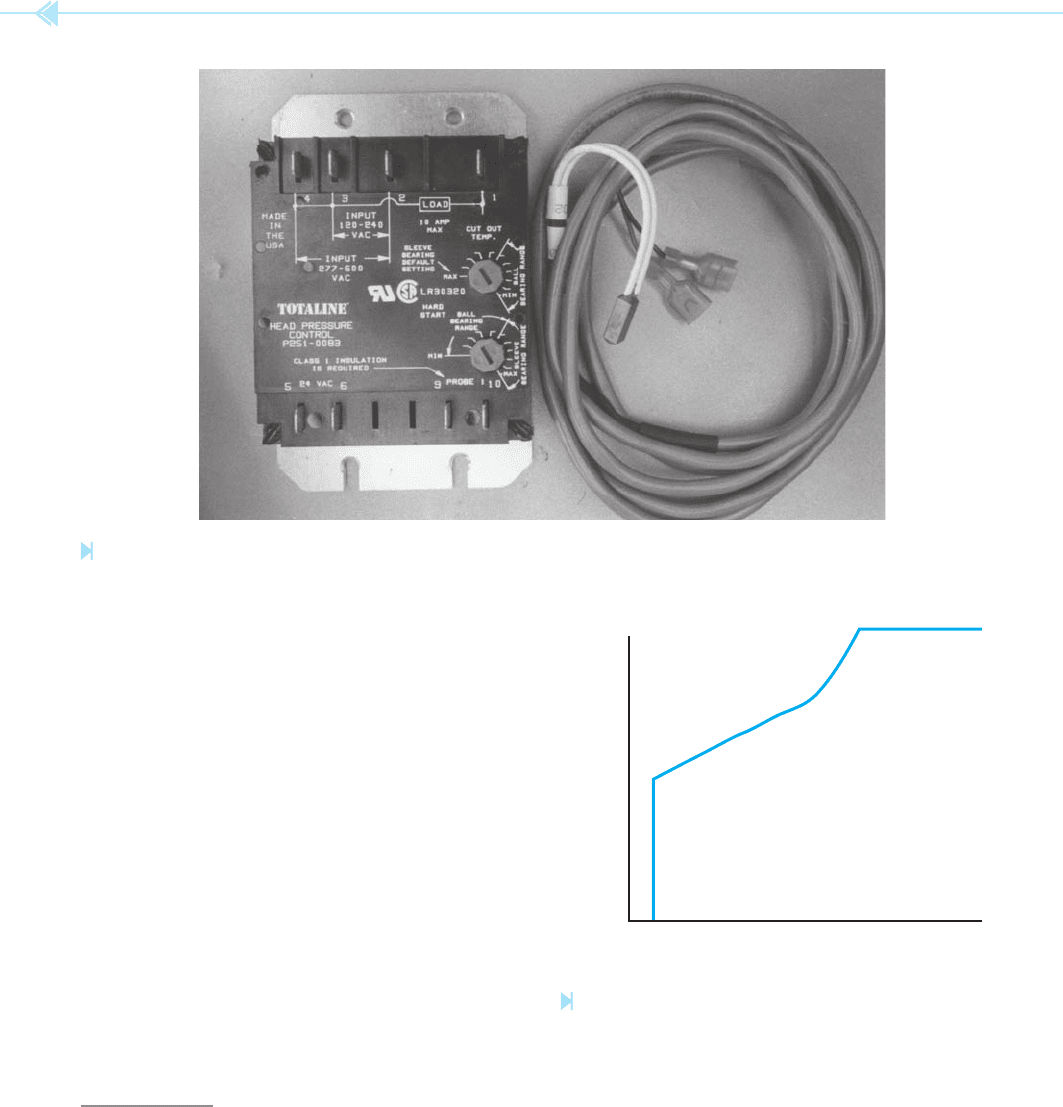
458 SECTION 7 Ice Maker and Refrigeration Controls
temperature. A thermistor is used to sense the tem-
perature. A decrease of temperature causes the unit
to reduce the voltage applied to the condenser fan
motor causing it to slow down. As the temperature
increases the output voltage increases permitting the
motor to increase speed. A chart illustrating typical
voltage and temperature relationships for a con-
trol that senses liquid line temperature is shown in
Figure 47–12. The voltage/temperature relationship
can be changed to some degree by changing the type
thermistor used to sense the temperature. Notice on
the chart that at temperatures below about 75°F the
motor is turned off and at temperatures above about
115°F full output voltage is applied to the motor.
The variable speed control helps eliminate some of
the pressure differential problems encountered with
fan cycle controls that simply turn on or off. A typical
connection diagram for this type control is shown in
Figure 47–13.
SHUTTERS
Another method for controlling head pressure is
with the use of shutters. Shutters can be opened or
closed to control the air ow across the condenser.
PERCENT LINE VOLTAGE TO MOTOR
100%
90%
80%
70%
60%
50%
40%
30%
20%
10%
0%
70 80 90 100100
TEMPERATURE OF LIQUID LINE IN °F
110 120 130 14
0
Figure 47–11
Variable-speed fan cycle control. (Source: Delmar/Cengage Learning)
Figure 47–12
Typical output voltage and temperature curve for a
variable-speed fan cycle control. (Source: Delmar/Cengage Learning)
They can be installed on the inlet or outlet side of the
condenser fan. A pressure-operated piston is used to
open the shutters and permit more air to ow. The
piston is connected to the high side of the system in
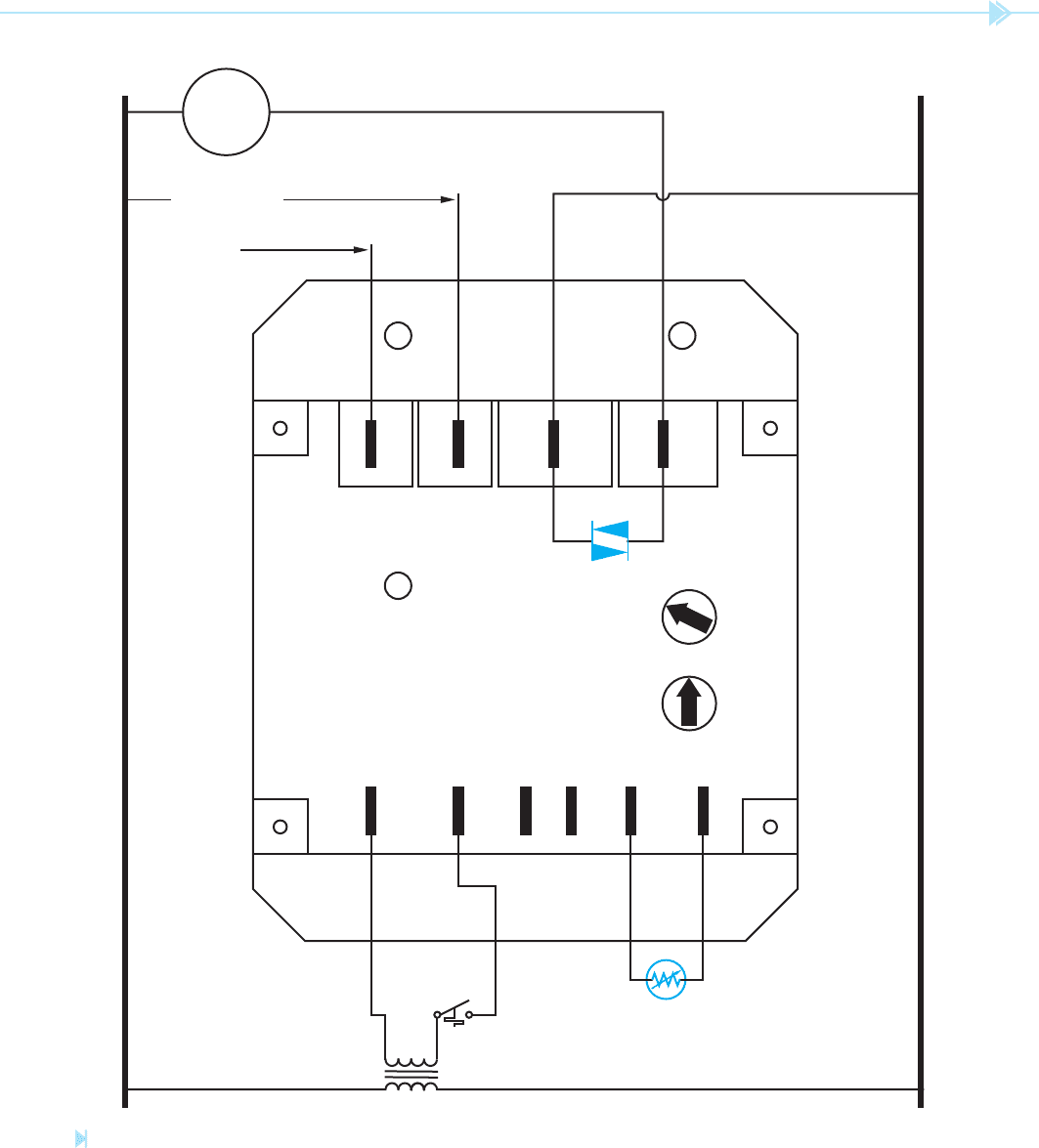
UNIT 47 Refrigeration Controls 459
MOTOR
TO TERMINAL 3 OR 4
120/240 VAC
277/600 VAC
L1 L2
THERMOSTAT
THERMISTOR
56 910
TRIAC
43 2 1
Figure 47–13
Basic connection for a variable-speed fan control.
(Source: Delmar/Cengage Learning)
